教材课后习题参考答案新版_学生版(1-4)章_
教材课后习题参考答案
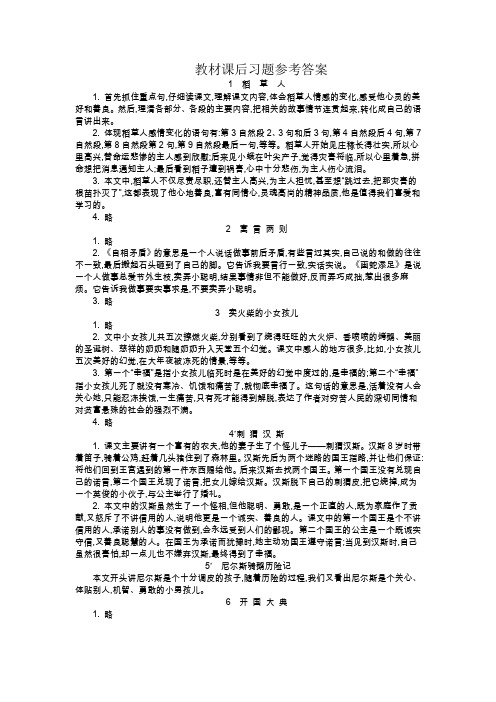
教材课后习题参考答案1 稻草人1. 首先抓住重点句,仔细读课文,理解课文内容,体会稻草人情感的变化,感受他心灵的美好和善良。
然后,理清各部分、各段的主要内容,把相关的故事情节连贯起来,转化成自己的语言讲出来。
2. 体现稻草人感情变化的语句有:第3自然段2、3句和后3句,第4自然段后4句,第7自然段,第8自然段第2句,第9自然段最后一句,等等。
稻草人开始见庄稼长得壮实,所以心里高兴,替命运悲惨的主人感到欣慰;后来见小蛾在叶尖产子,觉得灾害将临,所以心里着急,拼命想把消息通知主人;最后看到稻子遭到祸害,心中十分悲伤,为主人伤心流泪。
3. 本文中,稻草人不仅尽责尽职,还替主人高兴,为主人担忧,甚至想“跳过去,把那灾害的根苗扑灭了”,这都表现了他心地善良,富有同情心,灵魂高尚的精神品质,他是值得我们喜爱和学习的。
4. 略2 寓言两则1. 略2. 《自相矛盾》的意思是一个人说话做事前后矛盾,有些言过其实,自己说的和做的往往不一致,最后搬起石头砸到了自己的脚。
它告诉我要言行一致,实话实说。
《画蛇添足》是说一个人做事总爱节外生枝,卖弄小聪明,结果事情非但不能做好,反而弄巧成拙,惹出很多麻烦。
它告诉我做事要实事求是,不要卖弄小聪明。
3. 略3 卖火柴的小女孩儿1. 略2. 文中小女孩儿共五次擦燃火柴,分别看到了烧得旺旺的大火炉、香喷喷的烤鹅、美丽的圣诞树、慈祥的奶奶和随奶奶升入天堂五个幻觉。
课文中感人的地方很多,比如,小女孩儿五次美好的幻觉,在大年夜被冻死的情景,等等。
3. 第一个“幸福”是指小女孩儿临死时是在美好的幻觉中度过的,是幸福的;第二个“幸福”指小女孩儿死了就没有寒冷、饥饿和痛苦了,就彻底幸福了。
这句话的意思是,活着没有人会关心她,只能忍冻挨饿,一生痛苦,只有死才能得到解脱,表达了作者对穷苦人民的深切同情和对贫富悬殊的社会的强烈不满。
4. 略4*刺猬汉斯1. 课文主要讲有一个富有的农夫,他的妻子生了个怪儿子——刺猬汉斯。
最新部编人教版四下数学课本课后习题参考答案

10、略第67页做一做答案1、∠2=15º2、每个小三角形的内角和都是180º。
第68页做一做答案180º×(6-2) =720º提示:六边形可以分成4个三角形。
练习十六答案1、左图:180º-65º-37º=78º中图:90º-30º=60º或180º-90º-30º=60º右图:180º-20º-25º=135º2、(1)180º÷3=60º三个角都是60º。
(2) (180º-96º)÷2=42º三个角分别是96º、42º、42º。
(3) 90º-40º=50º三个角分别是90º、40º、50º。
3、1800-700×2=4004、发现:n边形都可以分成(n-2)个三角形,所以n边形的内角和=180º×(n-2)。
5、略6、提示:(1)另外两个角的度数之和一定是90º,即如果一个角是10º,那么另一个角就是80º,如果一个角是20º,那么另一个角是70º……(2)假设另一条边是acm,则a+3>4⇒a>1,3+4>a⇒a<7,所以另一条边一定比1cm长,比7cm短。
可能是2cm、3cm、4cm、5cm……7、1个 3个6个 10个……规律略第72页做一做答案1、3. 54 17.2 10.963.86 6.4 8. 162、(1)29. 8-22. 7=7. l(kg)(2)27. 5-24. 6=2. 9(kg)9岁比8岁增加得最多,增加了2. 9kg第73页做一做答案练习十七答案1、3. 4 9. 4 13. 7 0. 540. 7 1. 9 3. 3 0. 632、4.12 28.3 17.0425.6 4.68 4.263、0.95-0.35=0.6(kg)4、163.54元 159.26元 162.80元160.00元 322.80元5、10.32 16.08 20.243.08 44.3 0.456、7、原式=5.62元+3.09元=8.71元原式=1.03t+0.98t=2.Olt原式=4.35m+5.7m=10.05m原式=10kg-4.8kg=5.2kg原式=4.8km-3.05km=l.75km原式=6km-2.86km=3.14km8、75. 80+45. 50=21. 30(元) 75. 80+ 58. 00=38.00(元)92. 50+45. 50=33. 80(元)92. 50+58. 00=50. 50(元)9、0. 12m O.5lm O.87m 5.12m 8. 36m O.3秒10、(1)1.0 1.2(2)1. 31 1.36(3)4. 375 4.378(4)7. 877 7.872第76页做一做答案1、3. 24 3.6 117.32、38.5+4.8=43.3(元)50-43.3=6.7(元)练习十八答案1、9.1 8.1 0. 820.5 3.6 2.32、27. 07 17. 21 22. 2712. 41 43. 29 33. 433、39.36 9.69 24.475.2 36.39 8.224、分析:先求出海洋面积,再减去陆地面积。
部编版语文一年级上册教科书(教材)课后习题参考答案
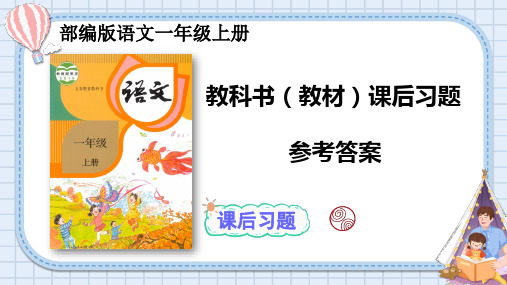
你喜欢哪个季节?仿照课文说一说。
提示:课文前三节都运用了叠词,说 出了事物的特征;课文第一、二节的句式 是“什么对什么说”,而第三、四节的句 式是“什么怎么样地说”。这些我们都可 以学着用一用。
示例:我喜欢夏天和秋天。
▷ 西瓜圆圆,他鼓着肚皮说:“我是夏天。” ▷ 柿子红红,他仰着小脸儿,对南飞的大雁
背诵指导:课文先写我们的国旗是五星红 旗,然后描述升国旗时的庄严情景,接着写我 们在升国旗时注视、立正、敬礼。结合自己参 加升国旗仪式的感受,熟读成诵。
课后习题 课文
5 影子
朗读课文,读准字音。
朗读指导:朗读时,先读准字音,“常、 着、是”是翘舌音,“子、在、左”是平舌 音,“子、着、的、友”读轻声。要重读表 示影子出现的位置的词和表现影子形状的词, 语速稍快。
读一读,说一说,看谁说得多。
金色的
雪白的
快活的
示例: 金色的(太阳/麦穗/沙漠) 雪白的(羽毛/棉花/梨花) 快活的(孩子/小鸟/星星)
课后习题 课文 12 雪地里的小画家
朗读课文。背诵课文。
朗读指导:第一句读得大声、响亮,读 出欢呼的语气。“啦”字用在句末,加强了 感叹语气,读出兴奋激动的感觉。想象下大 雪的时候,“小画家们”和我们一样兴奋地 跑向雪地,边跑边欢呼,朗读时要把自己的
写字 写作业
课后习题 课文 8 雨点儿
分角色朗读课文。
朗读指导:读小雨点儿的话时声音可以 天真一些,读大雨点儿的话时声音可以稳重 一些。问句要读出疑问语气,语速稍慢;回 答时要表现小雨点儿和大雨点儿都急着去自 己想去的地方的情态,语速稍快。
读下面的句子,注意读好停顿。
不久,有花有草的地方,花 更·红·了,
部编本人教版语文四年级下册教材课后题参考答案
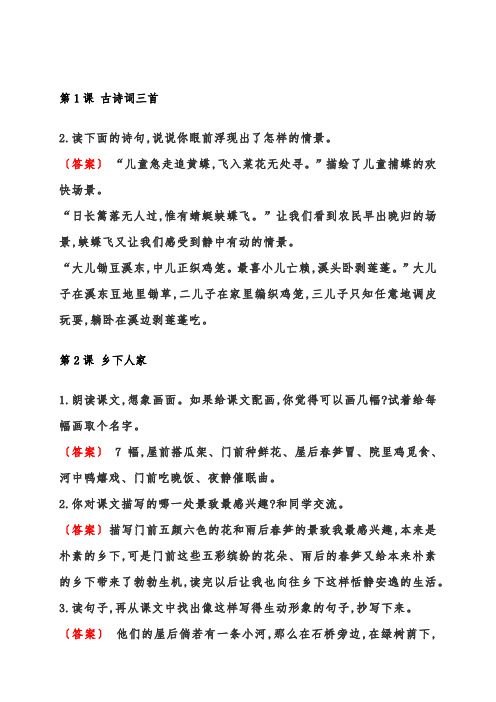
第1课古诗词三首2.读下面的诗句,说说你眼前浮现出了怎样的情景。
〔答案〕“儿童急走追黄蝶,飞入菜花无处寻。
”描绘了儿童捕蝶的欢快场景。
“日长篱落无人过,惟有蜻蜓蛱蝶飞。
”让我们看到农民早出晚归的场景,蛱蝶飞又让我们感受到静中有动的情景。
“大儿锄豆溪东,中儿正织鸡笼。
最喜小儿亡赖,溪头卧剥莲蓬。
”大儿子在溪东豆地里锄草,二儿子在家里编织鸡笼,三儿子只知任意地调皮玩耍,躺卧在溪边剥莲蓬吃。
第2课乡下人家1.朗读课文,想象画面。
如果给课文配画,你觉得可以画几幅?试着给每幅画取个名字。
〔答案〕 7幅,屋前搭瓜架、门前种鲜花、屋后春笋冒、院里鸡觅食、河中鸭嬉戏、门前吃晚饭、夜静催眠曲。
2.你对课文描写的哪一处景致最感兴趣?和同学交流。
〔答案〕描写门前五颜六色的花和雨后春笋的景致我最感兴趣,本来是朴素的乡下,可是门前这些五彩缤纷的花朵、雨后的春笋又给本来朴素的乡下带来了勃勃生机,读完以后让我也向往乡下这样恬静安逸的生活。
3.读句子,再从课文中找出像这样写得生动形象的句子,抄写下来。
〔答案〕他们的屋后倘若有一条小河,那么在石桥旁边,在绿树荫下,会见到一群鸭子游戏水中,不时地把头扎到水下去觅食。
天边的红霞,向晚的微风,头上飞过的归巢的鸟儿,都是他们的好友,它们和乡下人家一起,绘成了一幅自然、和谐的田园风景画。
秋天到了,纺织娘寄住在他们屋前的瓜架上。
月明人静的夜里,它们便唱起歌来:“织,织,织,织啊!织,织,织,织啊!”那歌声真好听,赛过催眠曲,让那些辛苦一天的人们,甜甜蜜蜜地进入梦乡。
选做你眼里的乡村景致是怎样的?用一段话写下来。
〔答案〕大树也绿,小草也茂盛,花朵也艳丽,田园的风光真是美。
近处,一棵棵大杨树挺直身板,抬起头,密密麻麻的绿叶里闪过一丝丝日影。
远远地看去,这些杨树就像一名名威武的保卫者。
小草又嫩又绿,茂密的草地就像一大块碧绿的地毯,躺在软软的绿地上,比躺在沙发上还要舒服。
那的野花不是一般的香,在千里之外都可以闻到。
小学语文教材课后习题参考答案
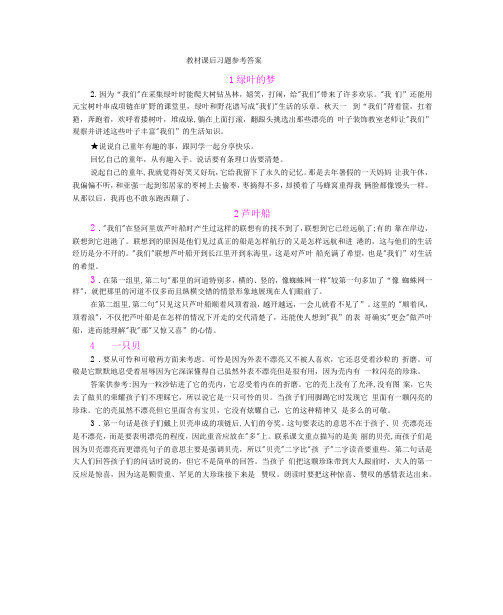
教材课后习题参考答案1绿叶的梦2.因为“我们"在采集绿叶时能爬大树钻丛林,嬉笑,打闹,给"我们"带来了许多欢乐。
"我们”还能用元宝树叶串成项链在旷野的课堂里,绿叶和野花谱写成"我们"生活的乐章。
秋天一到“我们"背着筐,扛着筢,奔跑着,欢呼着搂树叶,堆成垛,躺在上面打滚,翻跟头挑选出那些漂亮的叶子装饰教室老师让"我们”观察并讲述这些叶子丰富"我们”的生活知识。
★说说自己童年有趣的事,跟同学一起分享快乐。
回忆自己的童年,从有趣入手。
说话要有条理口齿要清楚。
说起自己的童年,我就觉得好笑又好玩,它给我留下了永久的记忆。
那是去年暑假的一天妈妈让我午休,我偏偏不听,和亚强一起到邻居家的枣树上去偷枣,枣摘得不多,却摸着了马蜂窝重得我俩脸都像馒头一样。
从那以后,我再也不敢东跑西颠了。
2芦叶船2."我们"在竖河里放芦叶船时产生过这样的联想有的找不到了,联想到它已经远航了;有的靠在岸边,联想到它进港了。
联想到的原因是他们见过真正的船是怎样航行的又是怎样远航和进港的,这与他们的生活经历是分不开的。
"我们"联想芦叶船开到长江里开到东海里,这是对芦叶船充满了希望,也是"我们”对生活的希望。
3.在第一组里,第二句"那里的河道特别多,横的、竖的,像蜘蛛网一样"较第一句多加了“像蜘蛛网一样",就把那里的河道不仅多而且纵横交错的情景形象地展现在人们眼前了。
在第二组里,第二句"只见这只芦叶船顺着风顶着浪,越开越远,一会儿就看不见了”。
这里的"顺着风,顶着浪",不仅把芦叶船是在怎样的情况下开走的交代清楚了,还能使人想到"我”的表哥确实"更会"做芦叶船,进而能理解"我"那"又惊又喜”的心情。
全新版大学英语(第二版)综合教程4学生用书课后习题答案(后附testyourself重要词翻译)
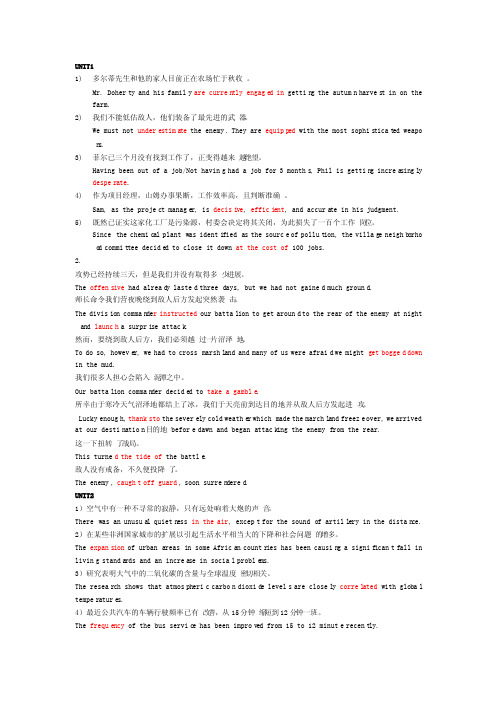
UNIT11)多尔蒂先生和他的家人目前正在农场忙于秋收。
Mr. Doherty and his family are curren tly engage d in gettin g the autumn harves t in on the farm.2)我们不能低估敌人,他们装备了最先进的武器。
We must not underestima te the enemy. They are equipp ed with the most sophis ticat ed weapo n s.3)菲尔已三个月没有找到工作了,正变得越来越绝望。
Having been out of a job/Not having had a job for 3 months, Phil is gettin g increa singl y desperate.4)作为项目经理,山姆办事果断,工作效率高,且判断准确。
Sam, as the project manage r, is decisi ve, effici ent, and accura te in his judgme nt.5)既然已证实这家化工厂是污染源,村委会决定将其关闭,为此损失了一百个工作岗位。
Since the chemic al plantwas identi fiedas the source of pollut ion, the villag e neighb orho o d commit tee decide d to closeit down at the cost of 100 jobs.2.攻势已经持续三天,但是我们并没有取得多少进展。
The offensive had alread y lasted threedays, but we had not gained much ground.师长命令我们营夜晚绕到敌人后方发起突然袭击。
选择性必修第一册课后习题学生版Unit 4 Section D Using Language (Ⅱ)
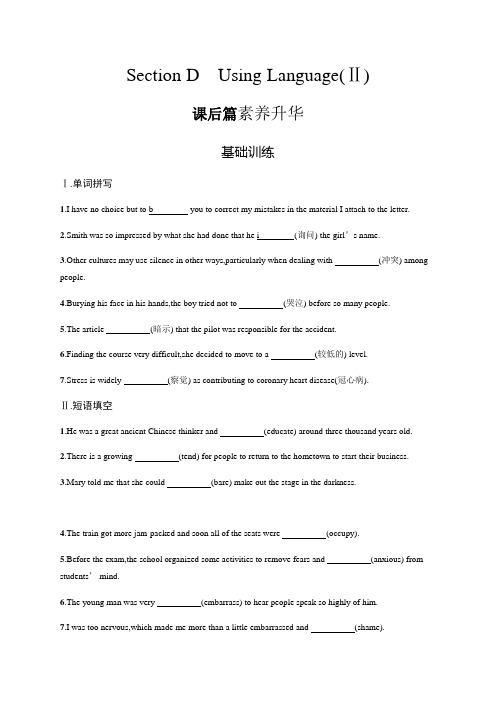
Section D Using Language(Ⅱ)课后篇素养升华基础训练Ⅰ.单词拼写1.I have no choice but to b you to correct my mistakes in the material I attach to the letter.2.Smith was so impressed by what she had done that he i(询问) the girl’s name.3.Other cultures may use silence in other ways,particularly when dealing with (冲突) among people.4.Burying his face in his hands,the boy tried not to (哭泣) before so many people.5.The article (暗示) that the pilot was responsible for the accident.6.Finding the course very difficult,she decided to move to a (较低的) level.7.Stress is widely (察觉) as contributing to coronary heart disease(冠心病).Ⅱ.短语填空1.He was a great ancient Chinese thinker and (educate) around three thousand years old.2.There is a growing (tend) for people to return to the hometown to start their business.3.Mary told me that she could (bare) make out the stage in the darkness.4.The train got more jam-packed and soon all of the seats were (occupy).5.Before the exam,the school organized some activities to remove fears and (anxious) from students’ mind.6.The young man was very (embarrass) to hear people speak so highly of him.7.I was too nervous,which made me more than a little embarrassed and (shame).8.He will have to make major (adjust) to his thinking if he is to survive in office.Ⅲ.完成句子1.They (号召) people and the government to take measures to fight against it.2.When you share a story with your friends,you care a lot more about how they(反应) it.3.If the child has to (向前倾)when walking with a loaded pack,it is too heavy.4. (无论什么困难) he may meet with,he will carry on his plan.5. (据说) the old man made a fortune abroad by collecting old things.能力提升Ⅳ.阅读理解There is one language that is used in every country in the world.The people who use it are young and old,short and tall,thin and fat.It is everybody’s second language.It is easy to understand,although you can’t hear it.It is sign language.When you wave to a friend who is across the street,you are using sign language.When you smile at someone,you are saying,“I want to be friendly”,but you are not using speech.You are using sign language.When you raise your hand in class,you are saying,“Please ask me.I think I know the correct answer.”Babies who can’t talk can point at things.They are using sign language.A policeman who wants to stop traffic holds up his hands.He is using sign language.Many years ago,a French priest,Charles Michel de Epee,became interested in education for deaf people.He invented a finger alphabet (字母表).It is still in use.People can make the sign for letters andspell words with their hands,and deaf people can read and understand them.Soon there were schools for the deaf in many countries.The only university for the deaf is Gallaudet College in Washington,D.C.Today,in the United States,there are special TV news programs for deaf people.The newsreader tells the news in sign language.At the same time,the words appear on the TV screen.The actors in the Theatre of Deaf don’t spell every word.Sometimes they use hand signs.When they put two hands together,it means sandwich.They can make a roof with them when they want to show a house.One finger in front of an actor’s mouth can mean quiet.You can talk to people who are behind windows that are closed.And when you go swimming with your friends,you can have conversations under water.How many hand signs do you use every day?1.What will you do if you want to express the idea that “I am very friendly” to someone?A.Raise your hand.B.Put one hand onto the other.C.Smile to the person.D.Make a roof with your hands.2.What does the underlined word “them” most probably refer to?A.Fingers.B.Hands.C.Sandwiches.D.Actors.3.What is the passage mainly about?A.An introduction to sign languageB.The importance of sign languageC.A famous priest in FranceD.Ways to use sign languageⅤ.应用文写作假定你是李华,你的英国朋友Peter来信向你咨询如何才能学好中文。
最新教材高中数学课后习题答案大全2019人A版

(2) ( x-1) ( x+2) = 0 的解为 x = 1 或 x = - 2,
∴ 集合 A = {1,-2} .
(3) 由-3<2x-1<3,得-1<x<2.∵ x∈Z,∴ x =
0 或 x = 1.
∴ 集合 B = {0,1} .
综合运用
3.解析 (1) { x | x = 2n,n∈Z 且 1≤n≤5} .
2.解析 (1) p 是 q 的必要不充分条件. ( 2) p
是 q 的充要条件.(3) p 是 q 的充分不必要条
件.(4) p 是 q 的必要不充分条件. ( 5) p 是 q
的既不充分又不必要条件.
3.解析 (1) 真.(2) 假.(3) 假.(4) 假.
综合运用
4.解析 (1) 充分条件.(2) 必要条件.( 3) 充要
3.解析 充 分 条 件: ( 1) ∠1 = ∠4, ( 2) ∠1 =
∠2,(3) ∠1+∠3 = 180°.
必要条件:( 1) ∠1 = ∠4,( 2) ∠1 = ∠2,( 3)
∠1+∠3 = 180°.
1.4.2 充要条件
练习
1.解析 ( 1) p 是 q 的充要条件. ( 2) p 是 q 的
A∪( B∩C) = {1,2,3,4,5,6,7,8} .
3.解析 “ 每位同学最多只能参加两项比赛”
表示为 A∩B∩C = ⌀.
(1) A∪B 表示参加 100 m 或参加 200 m 跑
的同学.
(2) A∩C 表示既参加 100 m 又参加 400 m
跑的同学.
综合运用
4. 解 析 因 为 A = { x | 3 ≤ x < 7 }, B =
- 1、下载文档前请自行甄别文档内容的完整性,平台不提供额外的编辑、内容补充、找答案等附加服务。
- 2、"仅部分预览"的文档,不可在线预览部分如存在完整性等问题,可反馈申请退款(可完整预览的文档不适用该条件!)。
- 3、如文档侵犯您的权益,请联系客服反馈,我们会尽快为您处理(人工客服工作时间:9:00-18:30)。
《Visual Basic程序设计基础》教材习题第1章 Visual Basic 6.0程序设计概述习题一、判断题参考答案:1.√2.√3.√4.×5.√6.×7.√8.×9.√10.√11.×12.√13.×14.√15.√二、选择题参考答案:1. C2. B 3.D 4.C 5.B 6.A 7.D 8.A 9.B 10.D三、填空题参考答案:1.对象、事件2.属性、方法、事件3.控件、屏幕(Screen)4.Left 5. Top 6.属性、<对象名>.<属性名>=<表达式>7.网格8.F o rm19.Load或Initialize或Resize或Activate(自动执行的先后顺序也按此排列)10.Activate、Deactivate四、程序设计题参考代码:程序1.界面设计参看表1。
表1 各控件的主要属性设置过程设计如下:Private Sub Command1_Click()Label2.Visible = False ‘使控件Label2看不见Label1.Caption = Text1.Text + ": 欢迎使用" + Label1.Caption Text1.Visible = False ‘使控件Text1看不见Command1.Enabled = False ‘使控件Command1不能用Command2.Enabled = True ‘使控件Command2能用End SubPrivate Sub Command2_Click()End ‘结束程序运行End Sub程序2.界面设计,过程设计如下:Private Sub Command1_Click() '字体变大Form1.FontSize = Form1.FontSize + 3Form1.Cls: Print "欢迎使用VB"End SubPrivate Sub Command2_Click() '字体变小Form1.FontSize = Form1.FontSize - 3Form1.ClsPrint "欢迎使用VB"End SubPrivate Sub Command3_Click() '字体加粗Form1.FontBold = TrueForm1.Cls: Print "欢迎使用VB"End SubPrivate Sub Command4_Click() '字体不加粗Form1.FontBold = FalseForm1.Cls: Print "欢迎使用VB"End Sub运行时,不得连续、过多次单击“字体变小”按钮,因为当FontSize属性值小于0会产生适时错误。
程序3.界面设计运行效果图过程设计如下(窗体Height值的计量包括标题、边框,而ScaleHeight值仅与窗体有效绘图区域的高度有关):Private Sub Form_Load()Text1.Text = "Visual Basic 程序设计"End SubPrivate Sub Form_Resize()Text1.Top = 0: Text1.Left = 0Text1.Width = Form1.ScaleWidth/2 '用Form1.ScaleWidth效果优于用Form1. WidthText1.Height = Form1.ScaleHeight/2 '用Form1.ScaleHeight优于用Form1. HeightCommand1.Top = Form1.ScaleHeight - Command1.HeightCommand1.Left = Form1.ScaleWidth - Command1.WidthEnd SubPrivate Sub Command1_Click()EndEnd Sub第2章程序设计基础习题一、判断题1.√2.×3.×4.×5.√6.×7.√8.√9.√10.×二、选择题1.B 2.D 3.A 4.C 5.C 6.B 7.A 8.D 9. C 10.A三、填空题参考答案1.String 2.4 3."aaa" 4.145 5.6 6.3 7.18 8.False9.(x Mod 10) * 10 + x \ 10 10.10 + Int( Rnd * 90 ) 11.a * b Mod c12.Log(x)+Sin(3.141593/6) 13.Const PI=3.1415926 14.日期15.Int(x)+1四、程序设计题参考答案程序1、Private Sub Command1_Click()Dim x As Double, y#, s#x = Val(InputBox("请输入x"))y = Val(InputBox("请输入y"))s = Sqr( (x ^ 3 + Exp(-6) * Log(y)) * (Sin(x)* Cos(y)) / (x * x + y * y) _+ (2 * Sin(90 * 3.14156 / 180) + 2 * x * Exp(y)) / Sqr(Abs(x * y)))Print "当x="; x; "当y="; y; "时,计算结果:"; sEnd Sub程序2、Private Sub Command1_Click()Dim s As Double, l As DoubleDim r As DoubleConst pi = 3.1415926r = Val(Text1.Text)l = 2 * 3.1415926 * rs = r * r * 3.1415926Label2.Caption = Str(s)Label5.Caption = Str(l)End Sub'删除文本框后Private Sub Command2_Click()Dim s As Double, l As DoubleDim r As DoubleConst pi = 3.1415926r = Val(InputBox("请输入半径:"))l = 2 * 3.1415926 * rs = r * r * 3.1415926Label2.Caption = Str(s)Label5.Caption = Str(l)End Sub程序3、Private Sub Command1_MouseMove(Button As Integer, Shift As Integer, X As Single, Y As Single)Command1.Move Int(Rnd * (Form1.ScaleWidth - Command1.Width)), Int(Rnd * (Form1.ScaleHeight - Command1.Height))End Sub程序4、Private Sub Command1_Click()Command1.Move Int(Rnd * (Form1.ScaleWidth - Command1.Width)), Int(Rnd * (Form1.ScaleHeight - Command1.Height))End Sub程序5、Private Sub Command1_Click()Text1.Text = Int(Rnd * (6)) + 1Text2.Text = Int(Rnd * (6)) + 1Text3.Text = Val(Text1.Text) + Val(Text2.Text)Form1.BackColor = RGB(Int(Rnd * 255) + 1, Int(255 * Rnd) + 1, Int(255 * Rnd) + 1)End Sub第3章结构化程序设计与数组习题一、判断题参考答案1.√2.×3.√4.×5.√6.×7.×8.√9.×10.×二、选择题参考答案1.A 2.A 3.D 4.C 5.C 6.D 7. D 8.B(提示:因为If m Mod i=0 Then Exit For :Next i 在同一行上,系统认为是if语句)三、填空题参考答案1.If x>y Then t=y: y=x: x=t 2.IS3.For i = 0 to 9: B(i) = InputBox("B(" & i & ")="): Next i4.ReDim c(n) as single 5.String 6.8 (4个元素,每个元素2个字节)四、程序阅读题(写出下列程序的运行结果)参考答案:程序1. 55 11 程序2. 20 程序3. 2 4 7 11 16程序4. 1 4 9 16 25程序5. 程序6.五、程序填空题参考答案:1.(1)s=1 (2)n (3)s=s+p2.(1)While r<>0 (2)r=m Mod n (3) print n3.(1)v = 0 (2)v=v+a(i) (3) v=v/n (4) a(i)>v4.(1)m (2)n (3) exit for (4) j<=n5.(1)k=i (2)k=j (3)a(k)=t (4)a(i) Mod 2 = 16.(1)j+i-1 (2)6-i+1 (3) print六、程序设计题参考答案:程序1.Private Sub Form_Click()Dim x As Integer, y As Integer, z As IntegerDim max As Integer, midd As Integer, min As Integerx = InputBox("请输入x的值:")y = InputBox("请输入y的值:")z = InputBox("请输入z的值:")If x < y Then t = x: x = y: y = tIf x < z Then t = x: x = z: z = tIf y < z Then t = y: y = z: z = tPrint x; y; zEnd Sub程序2.界面设计略,过程设计如下:Private Sub Form_Click()Dim x As Single, y As Singlex = InputBox("请输入x的值:")If x > 3 Theny = x + 3ElseIf x >= 1 Theny = x * xElseIf x > 0 Theny = Sqr(x)Elsey = 0End IfPrint yEnd Sub程序3.Private Sub Form_Click()Dim i As Byte, j As ByteFor i = 1 To 9For j = 1 To iPrint Tab(8 * (j - 1)); Trim(Str(i)); "*"; Trim(Str(j)); "="; Trim(Str(i * j)); Next jPrintNext iEnd Sub程序4.Private Sub Form_Click()Dim x As Integer, n As Integer, i As Integer, p As Single, s As Single n = Val(InputBox("请输入n"))x = Val(InputBox("请输入x"))s = 1 + x: p = 1For i = 2 To (n + 1) Step 1p = p * x / is = s + pNext iPrint sEnd Sub程序5.Private Sub Form_Click()Dim e As Single, a As Single, n As Integera = 1 '级数第1项为1e = 1 '将第1项存入en = 0 '变量n记录当前已累加的项数While a > (0.0001)n = n + 1: a = a / n: e = e + aWendPrint "e="; e; "n="; nEnd Sub程序6.方法一Public Sub Form_Click()'同构数是指一个数出现在它的平方数的右端'如25在25平方625的右端,则25为同构数'利用数字转字符再取出右端字符的方法进行判断Dim i As LongDim x1 As String, x2 As StringFor i = 1 To 1000x1 = Trim(Str(i)) '将i转字符型x2 = Trim(Str(i ^ 2)) '将i^2转字符型If Right(x2, Len(x1)) = x1 ThenForm1.Print i; "是同构数"End IfNext iEnd Sub方法二Private Sub Form_Click()Dim i&, ws As IntegerFor i = 1 To 1000ws = Len(Str(i)) - 1If (i * i - i) Mod 10 & ^ ws = 0 Then Print i; NextEnd Sub程序7.Private Sub Form_Click()Dim i%, j%, s As Double, x(10) As Single, y(10) As Single RandomizeFor i = 1 To 10 '生成10个坐标点x(i) = Int(Rnd * 90) + 10Print "(" & x(i) & ",";y(i) = Int(Rnd * 90) + 10Print y(i) & ")";NextFor i = 1 To 9 '按公式计算For j = i + 1 To 10s = s + Sqr((x(i) - x(j)) ^ 2 + (y(i) - y(j)) ^ 2)NextNextPrintPrint "各点距离之和:" & sEnd Sub程序8.Private Sub Form_Click()Dim n As Integer, m As Integer, i As Integer, j As Integerm = Val(InputBox("请输入a数组元素个数: "))n = Val(InputBox("请输入b数组元素个数: "))ReDim a(m) As Integer, b(n) As IntegerFor i = 1 To ma(i) = Val(InputBox("a(" & i & ")="))Next iFor i = 1 To nb(i) = Val(InputBox("b(" & i & ")="))Next iFor i = 1 To mFor j = 1 To nIf a(i) = b(j) Then Exit ForNext jIf j > n Then Print a(i);Next iFor j = 1 To nFor i = 1 To mIf a(i) = b(j) Then Exit ForNext iIf i > m Then Print b(j);Next jEnd Sub程序9.Private Sub Form_Click()Dim a(5, 5) As Integer, i As Integer, j As Integer For i = 1 To 5For j = 1 To 5 - i + 1a(i, j) = 7 - i - jNext jNext iFor i = 2 To 5For j = 5 - i + 1 To 5a(i, j) = j + i - 5Next jNext i'打印二维数组For i = 1 To 5For j = 1 To 5Print a(i, j);Next jPrintNext iEnd Sub程序10.(1)Option Base 1Private Sub Form_Click()Dim n As Integer, i As Integer, j As Integer, k As Integer, c%() n = Val(InputBox("请输入行数n:"))n = n + 1ReDim c(n, n)For i = 1 To nc(i, 1) = 1c(i, i) = 1Next iFor i = 3 To nFor j = 2 To i - 1c(i, j) = c(i - 1, j - 1) + c(i - 1, j)Next jNext iFor i = 1 To nFor j = 1 To iPrint c(i, j);Next jPrintNext iEnd Sub(2)Private Sub Form_Click()Dim n As Integer, i As Integer, j As Integer, k As Integer, c%() Do ‘假设n范围在1-9n = Val(InputBox("请输入行数n:"))Loop Until n > 0 And n < 10n = n + 1ReDim c(n, n)'产生杨辉三角形For i = 1 To nc(i, 1) = 1c(i, i) = 1Next iFor i = 3 To nFor j = 2 To i - 1c(i, j) = c(i - 1, j - 1) + c(i - 1, j)Next jNext i'打印杨辉三角形,每个数字占4列For i = 1 To n '打印n 行Print Tab((4 * n - 4 * i) / 2); '确定打印起始列For j = 1 To i '打印i 个数字Print Space(4 - Len(Trim(Str(c(i, j))))) & Trim(Str(c(i, j)));Next jPrintNext iEnd Sub第4章函数与过程习题一、判断题1.×2.√3.×4.×5.√6.×7.×8.√9. √10. √二、填空题参考答案1.按地址传送2.b() As Long 3.6 4.按值传递5.按地址传递6.Public x As Single 7.Static x As Integer 8.Form2.y9. function f9(a() as single,n) as single 10.sub f10(a() as single ,n as integer)11. sub f10(a() as single ,m as integer,n as integer ,max as single,min as single)12. c=form1.f12(a,b)三、程序阅读题(写出下列程序的运行结果)程序1. s = 2 程序2. command1 command2s = 5 1 1s = 9 1 21 31 4程序3. Byref时分别输出0 101 ,0 110 ,0 1011 ,0 10001(注意:语句Print n; f(n)在一行上结果如上)Byval时分别输出5 101 ,6 110 ,11 1011 ,17 10001程序4. 分别输出:0 3 2 3程序5. 结果(杨辉三角形)四、程序填空题参考答案:1.(1)ByeVal (2)n Mod k=0 (3)n = n \ i (4)Call pp(i) 2.(1)as string (2)n>0 (3)f16=chr(65+k)+f16 (4)n=n\16 3.(1)a() As Double, n As Integer (2)t = t * x (3)f = s4. (1)a() Aa Double,n as integer (2)n-1 (3)a(j) < a(k)五、程序设计题参考答案程序1.Function f1(x%, y%, z%) As IntegerDim max As Integermax = xIf max < y Then max = yIf max < z Then max = zf1 = maxEnd Function‘验证Private Sub Command1_Click()Dim a%, b%, c%a = 40:b = 120:c = 30Print f1(a, b, c)End Sub程序2.Private Function fsum(x() As Double, n As Integer) As DoubleDim i As IntegerFsum=0For i = 1 To nfsum = fsum + x(i)Next ifsum = fsum / nEnd Function程序3.界面设计略,过程设计如下:Private Sub ff(a() As Single, n As Integer)Dim i As Integer, x As SingleFor i = 1 To n \ 2x = a(n - i + 1): a(n - i + 1) = a(i): a(i) = x‘(a(1)⇔a(n),a(2)⇔a(n-1),...,a(i)⇔a(n-i+1))Next iEnd Sub程序4.Private Sub find(x() As Single,m As byte,n As Byte,ki As Byte,kj As Byte)xmax = x(1,1)ki = 1: kj = 1For i = 1 To mFor j = 1 To nIf Abs(x(i, j)) > Abs(xmax) Then xmax = x(i, j): ki = i: kj = j Next j, iEnd Sub程序5.Option ExplicitPublic Function g1(a%(), n%) As DoubleDim i%For i = 1 To ng1 = g1 + a(i)Nextg1 = g1 / nEnd FunctionPublic Function g2(a%(), n%) As Double Dim i%, t#t = g1(a, n)For i = 1 To ng2 = g2 + (a(i) - t) ^ 2Next ig2 = Sqr(g2) / nEnd Function'调用Private Sub Command1_Click()Dim x%(10), g#, i%For i = 1 To 10x(i) = iNext iPrint g2(x, 10) '计算g2End Sub。
